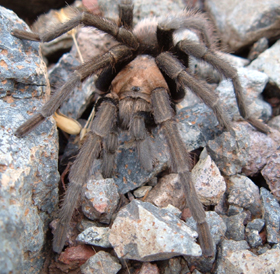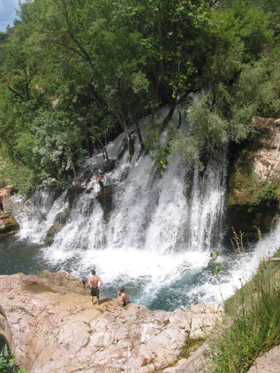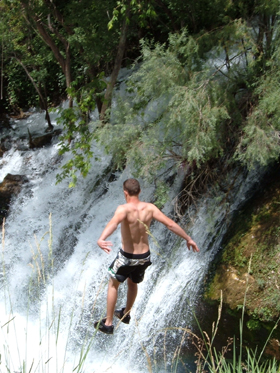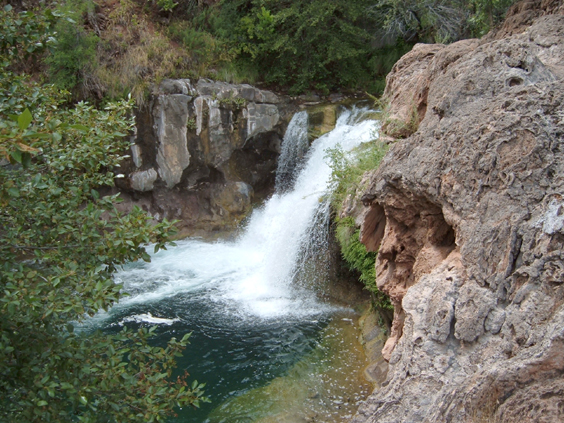That Creek in Northern Arizona, August 7, 2005
That Creek in Northern Arizona's abundant and reliable flow made it the site of one of the first hydroelectric dams in the state of Arizona. The Childs Power Plant was completed in 1909 on nearby Verde River. Most of the power went to the booming copper mines in Jerome and to the gold and silver mines in the Bradshaw Mountains. After World War I, demand for power increased, and the Irving Power Plant was completed on That Creek in Northern Arizona in 1916. The two plants were engineering marvels in their day, generating about 4.2 megawatts of electricity. There are some wonderful historic photos of the plants at www.pinestrawhs.org/childsirving.htm.

The 50-year license for the Childs Power plant expired in 1994, spurring a public debate on their future. The Arizona Power Corporation ultimately decided to decommission the plants, and on December 31, 2004, That Creek in Northern Arizona was restored to its natural flow.

Even before the restoration, That Creek in Northern Arizona was a magical place. Spring-fed pools with a constant temperature of 70 degrees made the canyon a delicious refuge from the summer's heat. But the area is also a geological wonder because of the travertine deposits that coat creekside rocks and plants. Scientists estimate that Fossil Springs deposits as much as 12 metric tons per day of calcium carbonate in a 6.7 km stretch below the Irving Power Plant.


Sunday, August 7, 2005, was my first trip to That Creek in Northern Arizona since the diversion. Our original plan was to do and out-and-back from the Irving Power Plant, but David suggested we do a two-car shuttle and hike down from the Fossil Springs trailhead all the way to the power plant. The flume trailhead is closed for destruction, so we left his Jeep at a campsite just north of the plant and then dropped off the Subaru at the Fossil Springs trailhead. Along the way we met up with a beaudacious tarantula and a patch of Jimson Weed.

The air was close after several days of heavy rain, so we were grateful for the cloud cover. The mottled gray cliff in the background is an enormous travertine dam that towers above Fossil Springs.


By the time the sun came out, we were safely immersed in the cool blue pools below the springs. Dennis and David took their turns on the rope swing at the second pool.


Past the pools we were deep in the Arizona jungle. The brush was thick, the mosquitoes were ravenous and we were soaked with sweat from head to toe. Around noon we crossed the stream just above the dam and emerged in blinding sunlight. To our right was a 100-foot wall of water pouring over the ancient dam. Directly across from us was an even larger torrent crashing downhill through mature trees. This must be the stream's long-diverted natural flow. Both waterfalls collide in a basin below the dam.


For more than 90 years, all of the water was diverted from That Creek in Northern Arizona through a series of flumes and tunnels about seven miles in length. We followed an old road below the flume a short distance, then scrambled down the bank to the creek.

It was at this point that David confessed that there was no actual trail from here to the waterfall. We made our way as best we could boulder-hopping, crashing through thick underbrush, and wading through thigh-deep water. But our efforts were more than rewarded with unforgettable sights and sounds the length of this reborn wild river. A field of brilliant green watercress flourishing in the smoky blue water. The crunch of submerged travertine under our feet. A natural water park at the base of a limestone cliff where we stopped for lunch. We saw no other people for the next two hours.

Soon we spotted a familiar tower of travertine and knew we were near the waterfall. Between the increased flow and the recent rains, the falls has been transformed from trickle to a roaring water canon. A powerful current sucks you toward the falls and then spits you back into the bubbles like a giant washing machine.

Before and After: The next two photos were taken one year apart and show the same waterfall before and after the Irving Power Plant was decomissioned!



We could have spent days here, but thick dark cumulus clouds boiled overhead and thunder echoed the length the canyon. We quickened our pace and kept our heads down. At about 3:30 we hauled our weary, muddy butts out of the canyon, just before the rain cut loose.

"Hey, David, how come we didn't think to transfer the beer from our car to yours?" "Because it was already there!" Total hiking time was approximately 6-1/2 hours: 1-1/2 hours from the Fossil Springs trailhead to the canyon bottom, 3-1/2 hours from the pools to the waterfall (including lunch and three dips), and 1-1/2 hours from the waterfall to Irving Power Plant. River shoes, a walking stick, sunscreen, and insect repellant are de rigeur. A machete might have come in handy. Good pie and reasonably priced rooms can be had at the Strawberry Lodge in Strawberry.
